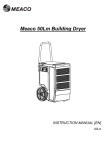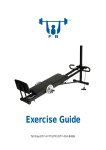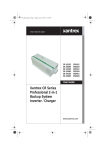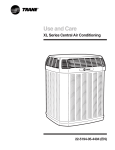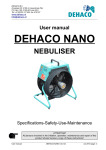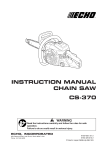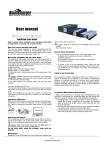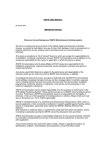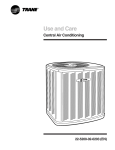Download Electric generator buying and safety tips. Safety. You don`t think
Transcript
Electric generator buying and safety tips. Safety. You don't think much about electricity — until the power goes out. The right type of generator can help keep you up and running. Depending on their wattage output, generators will run anything from a small lamp to a number of large appliances. To determine the size generator you will need, total the wattage of the maximum number of items you will be running simultaneously. For items with start up ratings higher than their run ratings, use the higher rating to determine your power requirements. Inductive load appliances and tools such as refrigerators, washers, and power tools require additional wattage for starting the equipment. The initial load only lasts for a few seconds on startup but is very important when calculating your total wattage. Before buying a generator, it’s important to consider what sort of generator best fits your budget, your wattage needs and whether you’d benefit from a portable or standby generator. Standby generators: Standby generators, offering anywhere from 7 kW to several hundred kW, help offset the harmful effects of power outages. Installed permanently as an emergency power source for your business, standby generators are hardwired to your business' electrical system and often get fuel from city gas or propane lines. Safety features can prevent injuries as well as damage to your generator. Quality standby generators will shut down if they lose oil pressure, overheat, or are being worked too hard. They should also have solid steel or aluminum enclosures, good mufflers to reduce noise, and be compliant with all relevant emissions regulations. Standby generators start themselves up around once a week to "exercise" - making sure they're ready when needed. This only takes around 15 minutes, but if noise is a concern, some standby generators have a "low idle exercise" feature that lets them run quieter than usual during this weekly workout. Portable generators: Portable generators provide power in remote locations, such as construction sites, for short periods of time. In a pinch, they can also power essential equipment during a power outage. Portable generators tend to be smaller and less expensive than standby generators. They have built-in fuel tanks, which allow them to run anywhere, and standard power outlets that can plug into ordinary extension cords. The smallest gasolinepowered portable generators are less than 1 kW and the largest reach around 15 kW. A sub-class of "towable" power generators — designed to be towed to construction sites — run on diesel fuel and can be 200 kW or more. Portable generators should have large fuel tanks for the best running time, a fuel indicator gauge, and enough receptacles to allow you to plug in all the devices you want to run. Always follow the directions for use supplied with your portable generator. Portable generators produce fumes that can cause serious health problems or death if used indoors. Understand your generator options. All generators have two main components: A motor that burns fuel (usually propane, natural gas, gasoline, or diesel) to supply power and a generator head that turns power into electricity. Together, the motor and the generator head comprise a standard generator. Generator motors typically use engines from well-known names such as Ford, GM, and Honda to drive the generator heads, which makes it easier to find parts and service than if you buy a no-name brand. Generators come in two basic designs: standby generators and portable generators. Don't push it to the max. Make sure you're comparing the rated capacity of various models, not maximum capacity. An electric generator can deliver its maximum capacity for no more than 30 minutes before starting to overheat - rated capacity is the level of power a generator can deliver on an ongoing basis. Usually, it's around 90% of the maximum power. Include everything you need. Some of the more important devices to connect to a standby generator are some of the least visible: sump pumps, sewage ejector pumps, and ventilation fans. Do a careful inventory of your electrical devices before committing to a certain wattage level. The single best way to save money on a standby generator is to limit the amount of devices you expect it to power. Consider that most power outages last less than a day; can't your office deal without air conditioning for a few hours? Turn to the pros for installation. Experienced interior electricians may not be as familiar with electric generators as they are with other types of electrical systems. Choose someone who's installed standby generators before and make sure they do all work up to code. Expect occasional exercise. Standby generators start themselves up around once a week to "exercise" - making sure they're ready when needed. This only takes around 15 minutes, but if noise is a concern, some generators have a "low idle exercise" feature that lets them run quieter than usual during this weekly workout. Establish Your Budget Purchasing a safe and reliable generator can take a chunk out of your pocketbook if you don’t carefully shop around for the best value for your money. Here are a few things to consider before buying generator: • • • • When shopping for a generator, take a look at whether additional accessories such as oil, a separate sub panel or a battery are included with the system. Otherwise you may have to purchase these items separately. If you’re interested in a standby generator, investigate how much installation will cost. Don’t forget to inquire about possible maintenance agreements that can be purchased separately from the generator. Regular maintenance service could save you money and trouble in the future. Explore the financing options available through specific manufacturers or retail outlets. Wattage Needs In most cases, a 5,000 - 7,000 watt generator can power a home’s essential appliances. To determine the wattage you will need, make a list of all appliances you would run during a power outage. Next, check the user’s manual or data plate on the back of each appliance on your list. Add the wattage of all of these appliances. Limit your choices to those devices that are truly essential during a power outage and you'll keep your total costs down. Run vs. Surge Wattage: Many appliances might list a run and surge wattage. The run wattage is the amount of electricity needed to run the appliance, whereas the surge wattage is the amount of electricity needed to start the motor. When determining your wattage requirements, consider the appliance with the greatest difference between surge and run wattage. Add that difference to the total wattage of all appliances. 5500 Watt 7550 Watt 10,000 Watt 12,000 Watt Computer Microwave Oven Garage Door Opener Washing Machine Color Television Water Pump 8 Lights Fax Machine Electric Range Security System Clock Radio Computer Hair Dryer Furnace Fan Dehumidifier Television Water Pump 8 Lights Sump Pump Refrigerator Microwave Oven Fax Machine Clock Radio Computer Television Water Pump 8 Lights Sump Pump Refrigerator Electric Range Hair Dryer Furnace Fan Microwave Oven Fax Machine Clock Radio Computer Television Water Pump 8 Lights Sump Pump Refrigerator Sump Pump Refrigerator Garage Door Opener Selecting a Generator Now that you’ve considered your budget and wattage requirements, it’s time to consider whether a portable or standby generator would best suit your home’s power needs. The comparison chart below outlines the main differences between both systems. Auto Power Transfer Refueling Noise Level Extension Cords Self-Test Permanently Mounted Diagnostic Panel Portable NO YES QUITE YES NO NO NO Standby YES NO QUIETER NO YES YES YES Installing your generator. Get to know exactly what the installation of your generator will involve before committing to a purchase. Then choose qualified electricians and plumbers, experienced with generator installation, to do the work up to code. Have a dealer or the professionals you plan to hire to install your generator evaluate your location and tell you what it'll take to install the system (and if you rent, have your landlord approve the installation). Standby generators wired into your electric system require proper installation to prevent generator failure or overheating, and damage to your existing wiring and equipment. You'll also need a plumber to connect the gas or propane line, if applicable. Standby generators can be sensitive to both fuel pressure and volume, so high-quality connections are important. Look at location: The location of your existing electric service panel and gas line is important. The generator will sit outside but near your building, much like a central air conditioner, and for ease of installation, it's best if it can be positioned near the electric panel. The generator will need to be installed on a level surface, most commonly, a concrete pad but occasionally hard rubber. Some dealers cover "everything" in their installation charge, including pouring a concrete pad. Get an automatic transfer switch: To connect a standby generator to your existing electrical system, you'll need a separate device called an automatic transfer switch. The transfer switch is an essential a safety system that prevents your generator from feeding electricity back to the neighborhood power grid. When the power goes out, the generator will start up automatically, and after a few seconds to let it stabilize, the transfer switch will connect the generator to your office. When power comes on again, the switch will disconnect the generator and return your setup to normal. Do not attempt to install a transfer switch yourself. Installation of transfer switches may require local permits - but it always requires a professional electrician. The model of transfer switch will depend mainly on the size of your generator. In very high-priority situations such as hospitals, higher-end transfer switches can be worth the extra cost. Consider installing a dedicated electrical sub-panel: In addition to the generator and transfer switch, you may want to invest in a dedicated electrical sub-panel, as well. Only your essential equipment is connected to the sub-panel, which is connected to the generator. That way, when power fails, your critical devices will get the emergency power without the risk of overworking your generator or having to turn off or unplug other equipment. Setting up an electrical sub panel may be included in an installation charge, or may carry a separate fee. Competent dealers of commercial generators can make a big difference in your overall satisfaction with your backup power system. Look for dealers who are knowledgeable and with a proven track record of dedication to generator sales and service. Fueling your generator. Generators can run on several different types of fuel. Some portable generators and standby generators even come in dual- or tri-fuel configurations, which allow you to switch from natural gas to gasoline or propane by reconnecting a hose. Diesel generators: Diesel is a popular choice of fuel for larger, commercial generators. Diesel generators tend to be dependable and somewhat less expensive to operate than generators that run on natural gas or propane, but diesel isn't as clean-burning. You'll need to have diesel fuel delivered and a proper tank to hold the fuel. Natural gas and propane generators: Standby generators can run on natural gas or propane. The standby generator connects to utility lines and draws fuel when necessary. Choose between natural gas generators and propane generators based on what's available in your area. Gasoline generators: Portable generators commonly run on gasoline and are considered gasoline generators. Gasoline can't be stored for very long, so consider a propane generator if you intent to keep a portable generator around for emergencies. Cooling your generator. Generators need an air cooling or liquid cooling system to prevent overheating. Like any motor, a generator motor creates quite a bit of heat, with faster generators producing more heat than slower generators. Generators made for the US market operate at one of two speeds: 1800 RPM or 3600 RPM. 1800 RPM motors typically last longer and run quieter; 3600 RPM motors are smaller and lighter. Air-cooled generators: Air-cooled generators cost less than liquid-cooled generators, but produce more noise and are less efficient. Portable generators are almost always air-cooled, 3600 RPM models. In some cases, you may be able to choose between the two RPM settings - go with 1800 RPM unless portability is important. Liquid-cooled generators: Standby generators 20 kW and larger typically run at 1800 RPM and use quiet, dependable, and effective liquid-cooled systems. Liquid-cooled generators typically cost more to purchase and maintain than air-cooled generators. Maintain your generator. Consistently well-maintained generators can last a long time. When looking at dealers or licensed service technicians, ask what maintenance services they'll provide. At a minimum, a standby generator requires an annual checkup of oil levels, air flow, and other factors. Expect to change oil and spark plugs, check coolant, and perform regular engine maintenance on an annual basis. Because maintenance and service are so important, you'll most often want a generator dealer in your local area. Generator safety tips. Many residents who lose power may turn to emergency generators to ensure a continuous flow of electricity to refrigerators, freezers, lights, fans and other appliances. While generators are a convenience in keeping appliances running during storm-related outages, they can also create hazards for homeowners and public service workers. Always exercise extreme caution when using an emergency generator. When operating a generator: • • • • • Always operate a generator in accordance with manufacturer's guidelines and instructions. Do not operate more appliances and equipment than the output rating of the generator. To avoid carbon monoxide poisoning, never use a generator indoors or in attached garages. Only operate the generator outdoors in a well-ventilated, dry area away from air intakes to the home. To avoid electrocution, plug individual appliances into the generator using heavy duty, outdoor rated cords with a wire gauge adequate for the appliance load. If connecting into the house wiring is necessary on a temporary basis, homes should have a transfer switch installed by a licensed electrician. A transfer switch allows your house to receive power directly from a portable generator as opposed to through the main circuit breaker. Transfer switches isolate the circuits supplied by the generator and prevent back feeding generator power out to your city’s electric distribution system. Back feeding can most commonly occur when a generator is connected directly to the electric panel or circuit in a home. Feeding power back into the utility system during an outage will energize the transformer serving the house and could pose a serious threat to public service workers and tree crews working to restore power in the area who may not know they are working with an energized line. Under no circumstances should portable generators be used indoors, including inside a garage, carport, basement, crawlspace or other enclosed or partially enclosed area, even with ventilation. Opening doors and windows or using fans will not prevent carbon monoxide build-up in the home. The carbon monoxide from generators can rapidly lead to full incapacitation and death, but it can’t be seen or smelled. Even if you cannot smell exhaust fumes, you may still be exposed. If you start to feel sick, dizzy or weak while using a generator, get to fresh air right away. Because you may have windows open to get fresh air while the power is out, be sure to place the generator away from windows, doors and vents that could allow carbon monoxide to creep indoors. To avoid electrocution, keep the generator dry and do rain or wet conditions. To protect the generator from operate it on a dry surface under an open canopy-like such as under a tarp held up on poles. Make sure your dry before you touch the generator. not use in moisture, structure, hands are It’s a good idea to install battery-operated carbon monoxide alarms or plug-in carbon monoxide alarms with battery backup in your home, according to the manufacturer’s installation instructions. If carbon monoxide gas from the generator enters your home and poses a health risk, the alarm will sound to warn you. Test the battery frequently and replace when needed. Be sure to turn the generator off and let it cool down before refueling. Gasoline spilled on hot engine parts could ignite. Store fuel for the generator in an approved safety can. Use the type of fuel recommended in the instructions or on the generator. Local laws may restrict the amount of fuel you may store, or the storage location. Ask your local fire department for additional information about local regulations. Store the fuel outside of living areas in a locked shed or other protected area. Do not store it near a fuel-burning appliance, such as a natural gas water heater in a garage. If the fuel is spilled or the container is not sealed properly, invisible vapors from the fuel can travel along the ground and can be ignited by the appliance’s pilot light or by arcs from electric switches in the appliance. Do not attempt to refuel your generator while it is running. Turn off all electrical appliances connected to the generator, then turn off the generator. Let the generator cool down before you attempt to refuel it.








